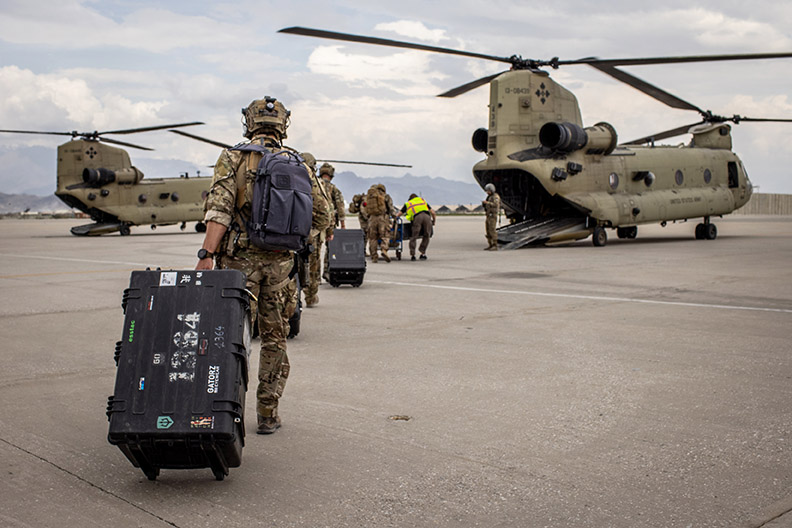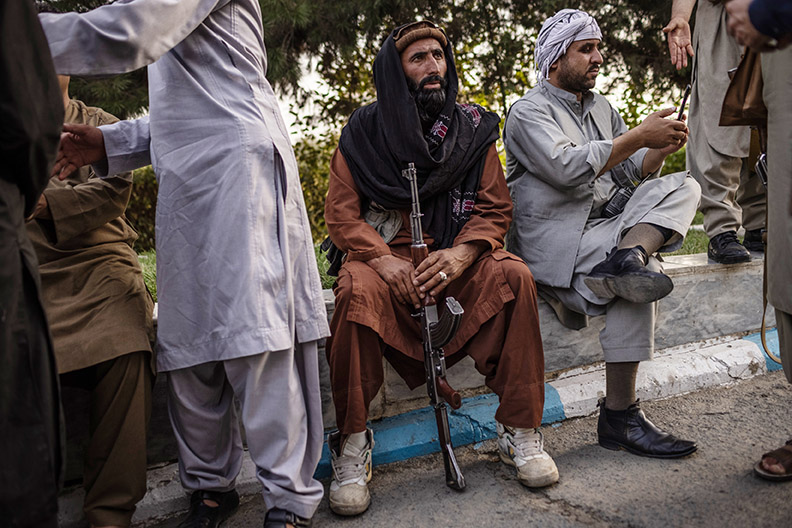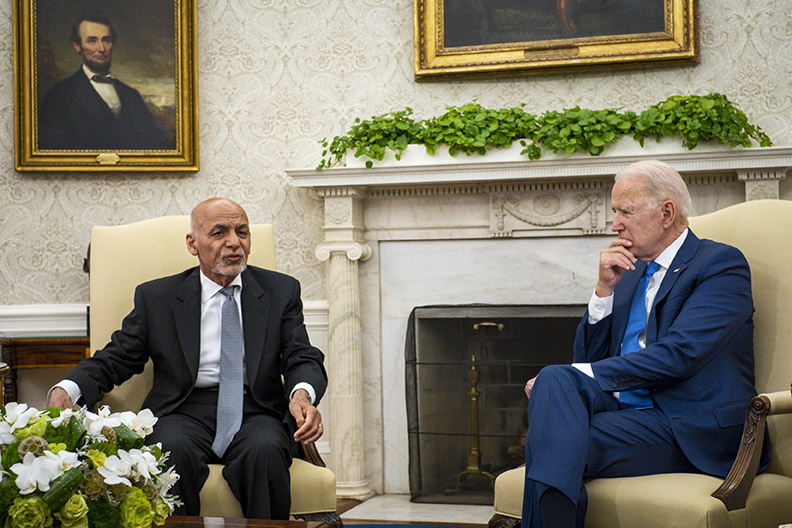
New York Times News Analysis by Roger Cohen
An era that began two decades ago with the shock of hijacked planes flying into American skyscrapers drew to a close this week with desperate Afghans clinging to American planes as they tried to escape the chaos of Kabul. Some fell; one was found dead in the landing gear.
A colossal bipartisan investment of U.S. force, treasure and diplomacy to defeat a hostile ideology bent on the creation of an Islamic Emirate of Afghanistan has failed. Over four presidencies, two Republican and two Democratic, more than 2,400 Americans gave their lives, and more than $1 trillion was spent, for shifting Afghan goals, many of which proved unattainable.
The curtain came down on the post-9/11 era, with the Taliban retaking control of the country that served as the base for the attack on America, a full-circle debacle for the United States that will engrave Afghanistan painfully in the national memory.

Mistakes and illusions and a particular American naivete, or hubris, about remaking the world in its image led to the swift Taliban takeover almost two decades after its defeat, but a more fundamental factor also played a part. With China flexing its muscles, the nation’s priorities shifted. The relative power of the United States is not what it was 20 years ago.
The country’s capacity and inclination to commit resources to faraway struggles ebbed. Absent the Cold War, Americans have little appetite for the kind of open-ended military commitment that cemented democracies in Germany, Japan, South Korea and elsewhere.
“As president, I’m adamant we focus on the threats we face today, in 2021, not yesterday’s threats,” President Joe Biden said Monday, defending his decision to proceed with a rapid military withdrawal.
“American troops cannot and should not be fighting in a war and dying in a war that Afghan forces are not willing to fight for themselves,” Biden said.
Yet if there has been a single thrust to Biden’s presidency, it has been the defense of democracies at an “inflection point” with repressive forms of governance spreading, and the reassertion of American values.
America is back. To do what?
“America is back,” has been the refrain. But the question will now be raised: To do what? A planned summit in December conceived to reinforce democracies looks far less credible now that Afghan schools may be closed to girls again and Afghans who believed in freedom are desperate to flee.
“For decades Afghanistan has been the victim of people who wanted to do it good,” said Lakhdar Brahimi, an Algerian diplomat who served as United Nations Special Representative for Afghanistan and Iraq. “At this point there was no good time to leave, so this was as good — or as bad — as any,” he added.
The chaos in Kabul as the United States and its allies scrambled to evacuate their nationals, and the Afghans who had helped them, has inevitably been compared to the desperate scenes in Saigon in April 1975 as North Vietnamese troops took the city. Then, as now, a homegrown guerrilla insurgency undid a superpower’s designs.
The analogy should not be overdrawn, however. The United States was bitterly divided over the Vietnam War. Today most Americans want out of Afghanistan. Their priorities are domestic.
As Biden said, an overriding American objective was achieved: Islamist terrorism, in the form of al-Qaida, was largely defeated over the past two decades. But the political Islam embraced by the Taliban has retained its magnetism as an alternative to secular Western models of governance.
It remains to be seen whether a newly savvy Taliban, honed by diplomatic experience that may have cooled something of the zealous ardor of the seminary, will honor promises to prevent Afghanistan becoming a terrorist haven again.
Debate will long rage over whether the United States should have maintained a modest military presence sufficient to keep the Taliban from power and preserve the hopes of the women and emergent middle class of Afghanistan who now feel betrayed.
There was little reason to think that what could not be achieved in 20 years might be one day. On the other hand, as Saad Mohseni, an Afghan entrepreneur whose MOBY group runs radio and TV networks in Afghanistan, argued, “Afghans have been pushed under the bus in the most unfair and irresponsible way.”
Disasterous US withdrawal

What seems beyond debate, for now, is the disaster the precipitous U.S. withdrawal has provoked. Just days ago, President Ashraf Ghani, who has now fled, thought he still had two weeks to negotiate an organized transition, according to a person who spoke to him then. In fact, without the United States, his was a house of cards.
Long skeptical of the purpose of the longest American war, Biden acted in the conviction that it was “highly unlikely” that the Taliban would be “overrunning everything and owning the whole country,” as he put it last month.
Those words seem certain to haunt the Biden presidency, even if there is blame enough to be shared by both parties. So, too, will images from Kabul of the shuttered U.S. Embassy, and of gun-toting Taliban forces taking over the government buildings that were supposed to enshrine an American-built democracy.
“I have no doubt this will be a huge liability for Biden, even if Trump boxed him in,” said Cameron Munter, a former U.S. ambassador to Pakistan, referring to the agreement the Trump administration signed with the Taliban in 2020 that stipulated the U.S. withdrawal this year.
That was the difficult legacy bequeathed to Biden. Still, his administration had options short of its accelerated withdrawal.
“The thing that is appalling is that the administration had no plan,” said Stephen Heintz, the head of a foundation that has been working on Afghanistan since 2011. “There was scarcely any consultation with NATO and little with the Afghan government. It’s a failure of intelligence, of planning, of logistics, and in the end a political failure, because whatever it is, it’s Biden’s.”
Others were more supportive of the president.
“Twenty years was a long time to give Afghan leaders to plant the seed of civil society, and instead they planted only the seeds of corruption and incompetence,” Rep. Jake Auchincloss, D-Mass., a former Marine who served in Afghanistan, told The New York Times.
Both Biden and his predecessor were responding, in different ways, to an inward-looking American mood. Policing the world is expensive, often thankless work, and domestic problems abound. The military withdrawal from Afghanistan accurately reflected a shift of priorities, including toward the sharpening great power rivalry with China.
But America-in-Afghanistan amounts to a chronicle of errors and misjudgments that pose fundamental questions for U.S. policymakers.
From the moment the United States decided to go to war in Iraq in 2003 on the basis of flawed intelligence — opening a second front and diverting attention and resources from Afghanistan — a sense that the Afghan conflict was a directionless secondary undertaking grew.
Massive Afghan electoral fraud
Defeating terrorism morphed perilously into nation building. But democracy was a far-fetched objective in a country that had never had a census, and where tribal loyalties were powerful. It was always unlikely that massive electoral fraud could be averted, or that millions of dollars in aid would ever reach its intended target.
The attempt to build a credible Afghan army turned into a fiasco with an $83 billion tab.
“We tried to build an Afghan military in the image of the Pentagon that actually cannot operate without us,” said Vali R. Nasr, a senior adviser on Afghan policy between 2009 and 2011. “It should not have depended on our air support or an ability the Afghans don’t have to service helicopters.”
The reckoning on this American failure seems certain to be painful. The inclination to build in the American image — rather than adapt to simpler, less ambitions Afghan needs and capacities — seems to carry a wider lesson for the United States in the world in the 21st century.
Americans did not know enough
Munter, the former ambassador to Pakistan, led the first Provincial Reconstruction Team in Mosul, Iraq, in 2006. He recalled arriving there and finding “there was no plan whatsoever.”
Officials distributing aid seemed more concerned with how quickly they could do it, rather than where it went, “so that they could convince the people on the Hill that we were spending the money allocated to us,” Munter said.
The Mosul experience, he added, “seemed like a miniature version of what happened on a much grander scale in Afghanistan.”
The element that so often seemed missing in American policy, both in Iraq and Afghanistan, was an ability to pose a fundamental question: What is it we know about where we are going?
“Americans have been very reluctant to acknowledge that they don’t know a whole lot about what was happening on the ground, may not know what they don’t know, and have made mistakes because they did not know enough,” Brahimi said.
Digitally connected middle class emerged
American naivete, if it was that, did however bring many benefits. Mohseni compared the last 20 years to a “golden age” that ushered Afghanistan from the 12th to the 21st century. Women could be educated again. A digitally connected middle class emerged. Infrastructure and technology linked people to the world.
“Afghans have changed forever,” he said. “For us, the stalemate was sweet.”
The question now is how much of all that the Taliban, themselves changed by the internet on which they depend, will attempt to reverse.
The most immediate threat they pose is certainly to Afghans, and particularly Afghan women, rather than to the United States. Anything seems possible, including violent reprisals and a massive refugee exodus.
“This is a devastating blow to American credibility that calls into question how sincere we are when we say we believe in human rights and women,” Heintz said.
When the late Richard Holbrooke was the special representative for Afghanistan from 2009 until his death in 2010, he insisted that all his team read Graham Greene’s “The Quiet American.”
In the novel, a well-intentioned and idealistic U.S. intelligence officer, Alden Pyle, confronts the bitter realities of the French colonial war in Vietnam as he tries to bring social and political change to a complex society.
Greene, through his cynical journalist narrator, writes: “I never knew a man who had better motives for all the trouble he caused.”
This article originally appeared in The New York Times.
c.2021 The New York Times Company



